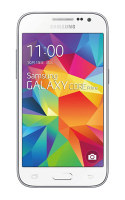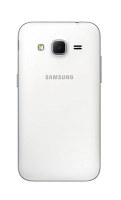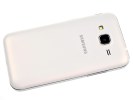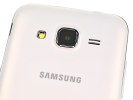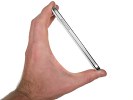Samsung Galaxy Core Prime review: Core values
GSMARENA TEAM, 30 DECEMBER 2014.
Introduction
The Galaxy Core lineup represents Samsung's take on the essential smartphone. The Galaxy Core Prime updates the base formula in two areas - a slightly better camera and slightly better chipset - and it serves as a smaller alternative to Galaxy Grand Prime.
The Core Prime was announced mere months after Galaxy Core II (not to mention Core LTE, Core Lite LTE and several others), but brings definite improvements over all members of the family, even if most specs are shared among the Cores.
For one, the 64-bit capable Snapdragon 410 is definitely a first. The 5MP/720p camera has been done on other Cores, but it is still the best in the lineup. The front-facing camera is the best one yet - a 2MP/480p shooter - that goes over the low bar of having no selfie camera at all or a 1MP one. It defiantly lacks the ambition of the Galaxy Grand Prime's selfie camera but it's also not very ambition when it comes to pricing so it all sounds fair.
Key features
- Optional Dual SIM version available
- 4.5" 480 x 800 TFT display with 207ppi
- Android OS v4.4 KitKat with TouchWiz UI
- Quad-core 1.2 GHz Cortex-A53 processor, Adreno 306 GPU, 1GB of RAM, Snapdragon 410 chipset
- 8GB built-in storage, microSD card slot
- 5MP camera with LED flash, 720p video recording; 2MP front-facing camera
- Cat. 4 LTE (150/50Mbps); Wi-Fi b/g/n; Bluetooth 4.0; NFC; GPS; microUSB, FM radio
- 2,000mAh battery
Main disadvantages
- Screen ppi is entry-level
- No screen protection glass
- No automatic brightness sensor
Coming off our Galaxy Grand Prime review, we know that a lot of the 64-bit benefits hang on an Android 5.0 Lollipop update. Considering the Core Prime was announced only recently, the prognosis on an update is good, but nothing is guaranteed.
The camera department is a definite update over the Galaxy Core II, where the 5MP snapper only recorded 480p video and there was a 480p front-facing camera. Three other Core models (Plus, LTE and Lite LTE) also shoot 720p video, but they all lack the Core Prime high quality selfie snapper.
Speaking of the Grand, in its review we discussed the recent popularity of large screens with low resolution. While in terms of pixel density the Galaxy Core Prime is in the same range, its entry-level position makes us more willing to forgive the sub-HD resolution and the lack of an IPS screen matrix.
True to its position in the market, the phone has a dual-SIM flavor. One version, the G360F, even reaches above its station with 4G LTE connectivity, but that's exclusive to China and Taiwan.
